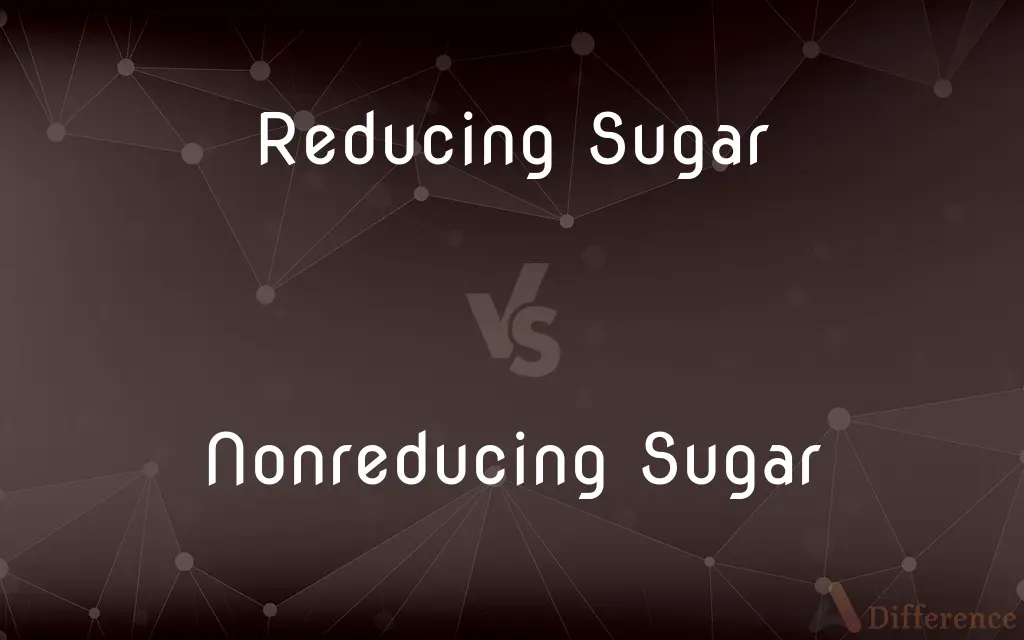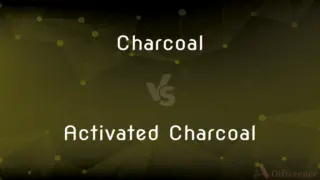Reducing Sugar vs. Nonreducing Sugar — What's the Difference?
Edited by Tayyaba Rehman — By Fiza Rafique — Published on December 2, 2023
Reducing Sugar can donate electrons in reactions, turning blue Benedict's solution to brick red; Nonreducing Sugar cannot.

Difference Between Reducing Sugar and Nonreducing Sugar
Table of Contents
ADVERTISEMENT
Key Differences
Reducing Sugar is a type of sugar that possesses a free aldehyde or ketone group, allowing it to act as a reducing agent. This means Reducing Sugar can donate electrons during a chemical reaction. Conversely, Nonreducing Sugar lacks this free aldehyde or ketone group, rendering it incapable of acting as a reducing agent in similar chemical reactions.
A classic test to identify Reducing Sugar is the Benedict's test. In this test, Reducing Sugar reacts with the blue Benedict's solution and reduces it to form a brick red precipitate. On the contrary, Nonreducing Sugar will not produce this change, leaving the solution blue.
In terms of examples, many simple sugars (monosaccharides) like glucose and fructose are Reducing Sugars due to their ability to reduce other compounds. Disaccharides can also be Reducing Sugars, like maltose and lactose. However, sucrose is a prime example of a Nonreducing Sugar, as it doesn't have the free functional groups needed to act as a reducing agent.
From a molecular structure perspective, the difference between Reducing Sugar and Nonreducing Sugar lies in their functional groups. Reducing Sugars have free carbonyl groups (either aldehyde or ketone) that can be oxidized. Nonreducing Sugars, however, have their carbonyl groups involved in glycosidic bonds, which prevents them from participating in oxidation reactions.
When considering dietary implications, both Reducing Sugar and Nonreducing Sugar can be found in the foods we consume. Their chemical properties, as described, do not directly correlate with their nutritional value or how our body metabolizes them.
ADVERTISEMENT
Comparison Chart
Presence of functional groups
Has free aldehyde or ketone groups
Lacks free aldehyde or ketone groups
Reaction with Benedict's solution
Turns solution brick red
Leaves solution blue
Ability to act as a reducing agent
Can donate electrons
Cannot donate electrons
Examples
Glucose, fructose, lactose
Sucrose
Carbonyl groups
Free and can be oxidized
Involved in glycosidic bonds and can't be oxidized
Compare with Definitions
Reducing Sugar
A sugar with free aldehyde or ketone groups.
Glucose is a Reducing Sugar that reacts with Benedict's solution.
Nonreducing Sugar
Cannot donate electrons.
The solution remained blue, signifying the presence of Nonreducing Sugar.
Reducing Sugar
Participates in oxidation reactions.
The Reducing Sugar oxidized and produced a change in the solution's color.
Nonreducing Sugar
Examples include many disaccharides.
The sweetness of the candy came from the Nonreducing Sugar, sucrose.
Reducing Sugar
Many monosaccharides and some disaccharides.
Lactose, a disaccharide, is also a Reducing Sugar.
Nonreducing Sugar
Doesn't change Benedict's blue solution.
Nonreducing Sugars won't produce a brick red precipitate with Benedict's test.
Reducing Sugar
Can donate electrons in chemical reactions.
Benedict's test identifies the presence of Reducing Sugar in a solution.
Nonreducing Sugar
Lacks free aldehyde or ketone groups.
Sucrose is a Nonreducing Sugar that doesn't react with Benedict's solution.
Reducing Sugar
Changes blue Benedict's solution to brick red.
The solution turned brick red, indicating Reducing Sugar was present.
Nonreducing Sugar
Carbonyl groups are involved in glycosidic bonds.
The structure of Nonreducing Sugar prevents it from participating in oxidation reactions.
Common Curiosities
Can Nonreducing Sugar react with Benedict's solution?
No, Nonreducing Sugar leaves the Benedict's solution blue.
Are all monosaccharides Reducing Sugars?
Most monosaccharides, like glucose and fructose, are Reducing Sugars.
How can one identify the presence of Reducing Sugar?
Using the Benedict's test, where the solution turns brick red.
Does the body metabolize Reducing Sugar and Nonreducing Sugar differently?
Both sugars provide energy, but their metabolic pathways can vary.
What's a primary example of a Reducing Sugar?
Glucose is a primary example of a Reducing Sugar.
Do Nonreducing Sugars have any functional groups?
They do, but they're involved in glycosidic bonds, preventing oxidation.
What makes a sugar a Reducing Sugar?
A Reducing Sugar has free aldehyde or ketone groups.
Which sugar type lacks free functional groups?
Nonreducing Sugar lacks free aldehyde or ketone groups.
Which common disaccharide is a Nonreducing Sugar?
Sucrose is a common Nonreducing Sugar.
What prevents Nonreducing Sugars from oxidizing?
Their carbonyl groups are involved in glycosidic bonds.
Why doesn't sucrose react in the Benedict's test?
Sucrose is a Nonreducing Sugar, lacking free functional groups for the reaction.
Are all disaccharides Nonreducing Sugars?
No, some like lactose are Reducing Sugars.
Are Reducing Sugars sweeter than Nonreducing Sugars?
The sweetness varies and is not directly related to their reducing or nonreducing nature.
What chemical property allows Reducing Sugars to donate electrons?
The presence of free aldehyde or ketone groups allows this.
Which sugar is more reactive in oxidation reactions?
Reducing Sugar is more reactive due to its free functional groups.
Share Your Discovery

Previous Comparison
Carbon Steel vs. Mild Steel
Next Comparison
Needed vs. NeedingAuthor Spotlight
Written by
Fiza RafiqueFiza Rafique is a skilled content writer at AskDifference.com, where she meticulously refines and enhances written pieces. Drawing from her vast editorial expertise, Fiza ensures clarity, accuracy, and precision in every article. Passionate about language, she continually seeks to elevate the quality of content for readers worldwide.
Edited by
Tayyaba RehmanTayyaba Rehman is a distinguished writer, currently serving as a primary contributor to askdifference.com. As a researcher in semantics and etymology, Tayyaba's passion for the complexity of languages and their distinctions has found a perfect home on the platform. Tayyaba delves into the intricacies of language, distinguishing between commonly confused words and phrases, thereby providing clarity for readers worldwide.










































